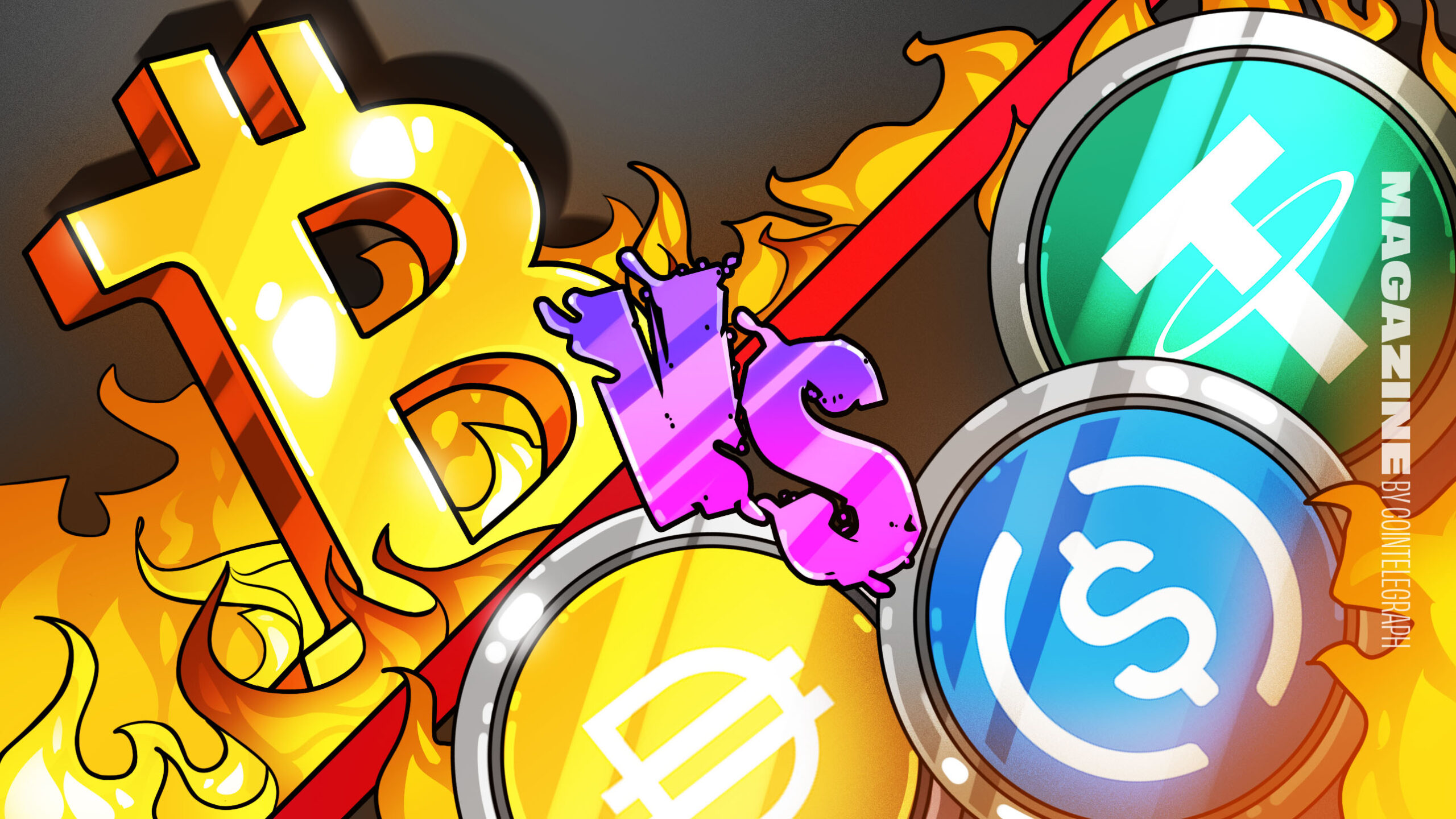- Charting Its Own Course of Economic Development
- Bitcoin Falls 14% In $500 Billion Crypto Selloff
- Altcoins With ‘Strong Fundamentals’ Will Shine After Bitcoin Rally, Says Crypto Trader – Here Are His Top Picks
- CleanSpark Is Outpacing Bitcoin Mining Peers Wednesday: What’s Going On? – Cleanspark (NASDAQ:CLSK)
- Bitcoin or altcoins? Who will win the holiday season with Santa rally
Down the road from Piccadilly Circus and up Shaftesbury Avenue, The Century Club in London is one of the private members’ clubs that are dotted around Soho and the rest of the UK’s capital.
Bạn đang xem: Bitcoin payments are being undermined by centralized stablecoins


For many, they are an outdated tradition of this most ancient of cities, a status symbol of privilege and an elite that was based on colonialism and slavery. For others, they are an intelligent place to do business away from the disruption of co-working spaces and noisy offices.
Traditionally slow to be innovative, it was refreshing to see last month that the Century Club has installed BTC terminals so members and their guests can settle their bills with cryptocurrency.
Founded this “century” in 2001 for the creative industry, the club has engaged payment provider Musquet to provide the terminals, and they have already proved popular with members, many of whom are of the demographic that has invested in cryptocurrency.
Tony Pearce, CEO of Web3 company Reality+, was one of the first members to use the terminals. He points out that while Bitcoin gets all the attention and mindshare from the general public, stablecoins are more prevalent in actually paying for things.
“Although there are a few bars in London now accepting BTC, I think stablecoins are a more widespread way of paying using digital currencies. This shift suggests that in the realm of everyday transactions, stablecoins have overshadowed BTC,” he says.
Pearce is right to cite the widespread under-use of BTC as a payment method. BTC payments have not only stopped growing but have significantly stalled.
According to the latest available figures from the US Federal Reserve, the use of cryptocurrencies for transactions (as opposed to investing) halved in 2023, down to just 1% of the population.


The rise and rise of stablecoins
According to Coinbase, the stablecoin market settled more than $10.8 trillion worth of transactions in 2023, and this figure is growing by 17% year-on-year. That compares with more than $8.4 trillion in transactions across the Bitcoin network. According to Chainalysis, fewer than 2% of Bitcoin transactions in 2023 were used for commerce.


Separating out the transactions used for payments as opposed to transfers or swaps is tricky. However, payment estimates from Visa, which aims to isolate stablecoin payments from normal transaction volumes, suggests that $2.5 trillion worth of stablecoins payments were settled in the 12 months to June and that this was a 10x increase on the number of stablecoin payments in 2020.
That means stablecoin payments have overtaken payments made via PayPal’s $1.5 trillion in 2023, and they are fast gaining ground on Mastercard’s $9 trillion.
“While major cryptocurrencies like Bitcoin dominate the headlines, stablecoins have surpassed all others in usage. Their prominence in transaction activity shows the high levels of utility they offer. They continue to play a pivotal role in broader adoption of crypto for everyday transactions outside of trading,” Kimberly Grauer, director of research at Chainalysis, said.
Has the idea of BTC payments died as stablecoins come to dominate the cryptocurrency payment landscape?
Stablecoins, such as USDt, USDC and even BUSD, offer many obvious advantages over BTC for payments. Their price stability means merchants and consumers avoid the volatility associated with BTC.
Many stablecoin transactions occur on efficient blockchain networks such as Ethereum layer 2s, BNB Smart Chain, Tron and Solana, which offer competitive transaction costs and faster block confirmations (compared to Bitcoin), enabling near-instant payments.
Stablecoins are far from a cypherpunk’s dream digital currency, though. The two largest providers, Circle’s USDC and Tether’s USDt are centralized projects with reserves of US dollars. The tokens can be frozen at the request of the authorities.
Major stablecoins, therefore, require a lot more trust from users than Bitcoin, but they seem happy to do so. Stablecoins such as USDC are backed by reserves and audited regularly, fostering trust among users and regulators. And Tether… well, it hasn’t collapsed so far.
Bitcoin fees and block times
The Bitcoin network itself (as opposed to Lightning) has long been impractical for small-value retail payments. Back in 2021, transaction fees sometimes averaged more than $60, and while things have improved since then, there are still regular spikes in price. Its reputation as a payment method is one that is expensive and slow.
BTC’s block time averages 10 minutes, and multiple confirmations are often required for security, leading to delays in transaction processing. This makes it less suitable for real-time payments compared to stablecoins on other networks.


The world’s most popular stablecoin, USDt, was actually first issued on Bitcoin’s Omni Network in 2014, and it was by far the most used until overtaken by Ethereum and Tron. USDt was phased out on Omni last year.
For the average user, setting up and using BTC wallets can be intimidating compared to user-friendly stablecoin wallets integrated into popular fintech apps. Stablecoins also benefit from simple fiat on- and off-ramps, which streamline their adoption. You can put in $100 and get something very close to 100 USDC.
Read also
Xem thêm : Chinese manufacturing, Bitcoin’s monthly fall, Gold gains
Features
‘Raider’ investors are looting DAOs — Nouns and Aragon share lessons learned
Xem thêm : Chinese manufacturing, Bitcoin’s monthly fall, Gold gains
Features
The real risks to Ethena’s stablecoin model (are not the ones you think)
Despite these challenges, BTC payments are not completely dead. They are simply used for high-value payments.
Large companies like PayPal and Tesla (at least temporarily) have accepted BTC payments; the recent presidential campaign was more than happy to accept them. Even as stablecoins gain traction, BTC remains a symbol of innovation and freedom, making it attractive to forward-thinking businesses. It’s also uncensorable, unlike those popular centralized stablecoin providers.
Can Lightning Network make Bitcoin payments great again?
Bitcoin’s scalability issues are being addressed through layer-2 solutions such as the Lightning Network (and some EVM-based Bitcoin L2 chains). By enabling faster and cheaper transactions, the Lightning Network still has the potential to revitalize BTC’s use as a potential payment method.
Companies such as Strike and Cash App leverage the Lightning Network for remittances and micropayments, showcasing BTC’s potential in real-world applications.
According to the latest numbers from CoinGate, the share of Bitcoin payments made via the Lightning Network was 5.98% in 2022, 7.95% in 2023, and has reached 14.51% so far in 2024.
Finding a total USD figure for Bitcoin payments is difficult because of its open network and trying to track what movements are for retail or otherwise. However, the graph below sheds some light on the differences between Bitcoin and Lightning Network and their respective potential.


The Bitcoin network handles a higher volume of larger transactions and is often used for significant transfers or settlements. In contrast, the Lightning Network is optimized for smaller, frequent payments, offering faster transaction times and lower fees.
While the Bitcoin network remains dominant for onchain transactions, the Lightning Network is experiencing growth, particularly for microtransactions and scenarios requiring instant payment confirmations.
There are moves to make Lightning use even easier, such as Lightspark, which removes the complexities that come with implementing and managing a Lightning node to reliably send and receive transactions.
The firm also built Lightspark Predict — an AI-based smart engine that aims to optimize liquidity requirements and routing in real time to maximize transaction success rates and finality times.


While Lightspark’s mission to drive mass adoption of BTC for payments could challenge the dominance of stablecoins, it’s unlikely to render them obsolete.
And Lightning use is increasing off a low base, and the network has struggled to gain mainstream adoption due to the difficulties retail users have with the technology and the volatility of Bitcoin. Why spend BTC today when it could be worth 30% more tomorrow? Why accept it for payments when it could be worth 30% less?
UK-based crypto influencer Jonny Fry, who in December gave evidence at the UK Parliament to the committee looking at the Digital Assets bill, is the publisher of the Digital Bytes newsletter and gives a reality check when it comes to using BTC as a payment method.
“Due to its volatility, BTC is not ideal as a form of payment for many as users may end up receiving a lot more or less than they expected and likewise users can end up paying a lot more than they expected to.
Read also
Xem thêm : Chinese manufacturing, Bitcoin’s monthly fall, Gold gains
Features
Lushsux: A decade of ass-whoopin’ and skullduggery in a single NFT
Xem thêm : Chinese manufacturing, Bitcoin’s monthly fall, Gold gains
Features
You can now clone NFTs as ‘Mimics’: Here’s what that means
Bitcoin has some advantages, however
Tether and Circle declined to comment on this article, but Claire Cummings — managing partner at Cummings Pepperdine, London-based advisers on crypto, (UK regulator) FCA and Real World Assets — said Bitcoin actually has an advantage for payments in many parts of the world because it’s not in the cross hairs of regulators.
“From the UK regulatory perspective the key difference is that the FCA has said that BTC is not a regulated asset. By contrast, stablecoins are top of the list for new UK regulations.”
“While stablecoins are generally issued by a legal entity, there is no such body behind BTC.There’s no Satoshi Limited, for example,” she says.
Then there are the BTC stories that have received wide publicity with their advocation of cross-border payments, especially in regions with unstable currencies or limited access to banking.
The El Salvador story is well-known after it adopted BTC as legal tender, but even there, wallet problems and other issues mean Salvadorans have been too slow to adopt the cryptocurrency.
Fry says that Bitcoin can still be used as a base currency, however, via cards that automatically convert it into local fiat when it’s spent.
“Using BTC and many other cryptos is relatively easy to use via a Mastercard or Visa debit card accepted by millions of merchants globally,” he says.
Store of value, not a payment method
Jason Meyers, founder of Auditchain Labs AG and the developer of Pacioli.ai, says Bitcoin has become a store of value rather than a form of currency.
“The evolution of BTC payments started in 2013 with BTC Suisse in Zug, Switzerland and was eventually used to pay taxes in the Canton of Zug. As the price rose through each cycle and supply began to decline, BTC’s utility moved from a medium of exchange to a store of value,” he says.


“This fundamentally changed when 12 BTC ETFs were approved in January 2024, leaving stablecoins as the preferred medium of exchange, as users prefer not to spend BTC in a bull market, further making stables the preferred rail of choice,” he concludes.
But with governments around the world considering adopting Bitcoin as a reserve asset that helps back their currencies, Bitcoin may get the last laugh. Bitcoin is already backing the wealth and portfolios of many of the most frequent stablecoin users.
“It’s not a zero-sum game. While BTC remains the Godfather of cryptocurrencies, stablecoins have carved out an essential niche in the digital payments landscape,” says Roshi Sharma, Partner at LawBEAM — a legal firm advising crypto and blockchain clients. “We’re seeing a symbiotic relationship emerge where BTC’s strength as a store of value actually complements stablecoins’ utility for everyday transactions.”
“The market has organically evolved with BTC as the anchor of the crypto ecosystem and stablecoins as the practical rails for commerce. For example, my company accepts stablecoin payments for our legal services, but not payments in BTC.”
So, it looks as if stablecoins and BTC will play complementary roles. Stablecoins excel in situations where stability and speed are paramount, such as everyday purchases and remittances. BTC, on the other hand, shines as a decentralized, censorship-resistant payment option and a long-term store of value.
Stablecoins often serve as an on-ramp to BTC. Many users start their cryptocurrency journey with stablecoins due to their familiarity with fiat currencies, later transitioning to BTC for investment or other purposes. This symbiotic relationship suggests that both technologies can co-exist and thrive.
But Bitcoiners sometimes find it difficult to accept any competition. Rajesh Sinha is the founder of Launchnodes, and his words probably echo the thoughts of many when he dismisses stablecoins as fiat pretenders.
“BTC and stablecoins serve entirely different purposes. Stablecoins mirror fiat currencies, inheriting their vulnerabilities to inflation and debasement.”
“BTC stands apart due to its mathematically capped supply — positioning it as a supreme, powerful store of value that surpasses stablecoins, gold and other assets. BTC resists censorship and centralized control, is borderless, and offers a hedge against monetary instability and eroding purchasing power.”
Subscribe
The most engaging reads in blockchain. Delivered once a
week.




Monty Munford
Monty Munford writes regularly for the BBC, The Economist and City AM and has been a tech columnist for Forbes and The Telegraph. He also runs a growth and visibility consultancy and has appeared at more than 200 events and conferences, interviewing figures such as Tim Draper, the late John McAfee, Sir Tim Berners-Lee, Steve Wozniak, Kim Kardashian, Guns N’ Roses and many others.
Nguồn: https://rentersinsurance.cyou
Danh mục: News








